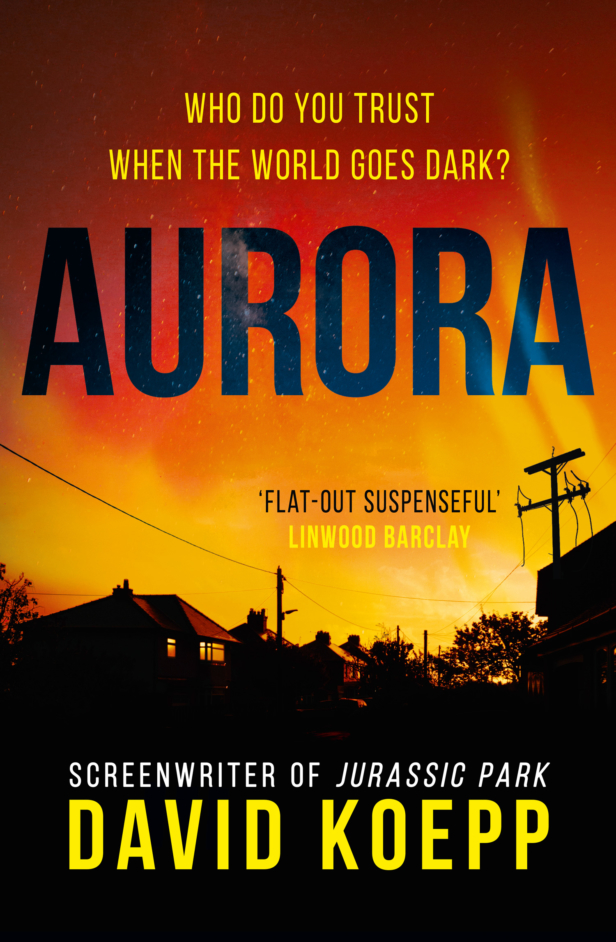What would happen if all electricity was gone? Well, wonder no more because new sci-fi novel, Aurora, deals with an event that Earth is well overdue – a solar flare that cuts off the world’s electricity.
Aurora is the latest novel by Jurassic Park screenwriter David Koepp and we’re delighted not only to reveal its electrifying cover (above) but we’re also giving you a sneak peek into the novel with an exclusive extract!
Here is a synopsis for the novel…
When the lights go out no one is safe… A planet without power.
When a solar storm hits the earth, the lights go out across the planet. But this time the blackout won’t be over soon – it could last for years. Aubrey and her stepson now face the biggest challenge of their lives.
A society without rules.
Soon they hear rumours of riots, the struggle for food becomes real, and even within their small communities, the rule of law is collapsing. Aubrey’s estranged brother Thom, a self-made billionaire who abandoned her years ago, retreats to a gilded desert bunker where he can ride out the crisis in perfect luxury.
A race to build a better world…
But the complicated history between the siblings is far from over, and what feels like the end of the world is just the beginning of a personal reckoning long overdue…
David Koepp has written more than two dozen feature films in a wide variety of genres, including the first two Jurassic Park films, Death Becomes Her, Spider-Man, Panic Room, and War of the Worlds. Some of the films he’s both written and directed are Stir of Echoes, Secret Window, Ghost Town, and Premium Rush, the latter two co- written with John Kamps.
Now, you can read an extract from Koepp’s latest novel Aurora right here at SciFiNow! Turn off the lights and enjoy…
Aurora, Illinois
6:32 a.m., Tuesday, April 14The thing about Norman Levy was that everyone knew Norman Levy. As a college professor at the University of Chicago, he’d been a magnetic force for talented and curious people and could always spot a kindred spirit when he saw one. Students who’d never quite fit in any- where felt utterly at home in the professor’s cramped college office, or over dinners and coffees and drinks at his wood-frame house near the end of Cayuga Lane, in nearby Aurora. Norman had dedicated his entire professional life to the study of the sun, but his real and abiding interest was in people. Norman, a childless widower, collected friends the way some people collect butterflies, but not to press them into a book; no, he wanted to prod and question and provoke them, to talk to them. There was, he was certain, absolutely nothing more worth doing than talking to people.
But not at 6:32 a.m. Central Standard Time, which was the exact moment when the phone on the wall in his kitchen rang on Tuesday, April 14. Norman, standing at the sink and staring out the window while the coffee brewed, stirred himself from his pre-caffeine reverie turned, and scowled at the phone for a moment. A line from a movie ran uselessly through his head—“None of my friends would call at this hour”—which was a lie; it was the curse of knowing people in myriad time zones. Norman shuffled over to the phone, tilted his glasses up so he could read the caller ID, and saw Silver Spring, Maryland. He picked up the handset.
“We’ve talked about this,” Norman said.
The voice from the other end was tense and excited. “Did you see any imaging from GOES-16 in the past twenty-four hours?”
“It’s six-thirty in the morning here, kiddo.”
“And I’m calling you anyway, Norman. So, imagine.”
Norman could hear the urgency in Perry St. John’s voice, and he cleared his throat, pulling himself to attention. He liked Perry and had since the moment the kid walked into his Introduction to Astrophysics class, listened to one lecture, then went right up to the revered professor and announced that he was looking for a mentor and had just settled on Norman. Who could resist that kind of chutzpah? Twenty years of dinners and phone calls and e-mails after that first day in class, Perry was one of the lead researchers at NOAA’s main observation station monitoring solar events. He put up with the lily-white astronomic industry giving him second looks and suspicious glances and, boy, did he get tired of saying, “Yes, Neil deGrasse Tyson is a great inspiration to me.” But he stayed with it, even when they started pushing him into media interviews just so they could have a Black face out there, because it was the job he was born to do. He liked to tell people he was a weatherman, which was technically true, but the kind of storms he monitored made category 5 earth hurricanes look like spring showers.
He repeated his question to Norman. “Have you seen imaging from the past cycle?”
“Last night,” Norman said, “and thank you again for the login. Hours of fun. Hours, Perry.”
“Did you see the flare?”
“Yes. Two of ’em, big ones. SUVI picked it up. They saturated the X-ray irradiance sensors, so I haven’t checked back. Why?”
Perry paused on the other end, thinking. “Is it possible they masked a secondary burst? Or tertiary?”
Norman furrowed his brow. “I suppose. Did the radiation hit DSCOVR yet?”
DSCOVR, the Deep Space Climate Observatory satellite, had been a crucial tool in the monitoring of space weather in general and solar activity in particular since late 2015, when after its successful launch it took up its orbit at Lagrange point 1, a neutral gravity sweet spot about a million miles from the earth. From there, DSCOVR essentially hovered in place between the earth and sun, the array of sensors in its nose beaming near-to-real-time information back to NOAA.
“Yes,” Perry answered, “they’ll miss earth by seven degrees in about forty-five minutes. It’s what’s behind them I’m talking about.”
“What’s behind them?”
“There was a third flare, zero degrees of inflection, and it’s moving through cleared space. New images are posted in the nowcasting. Take a look. I’ll wait.”
Ignoring the coffee, Norman took the cordless phone into his study and sat at the big oak dining table he used for a desk. He flipped open his laptop, cradled the phone on his shoulder, and went directly to the NOAA site that featured integrated images from GOES-16 and NASA’s orbiting Solar Dynamics Observatory. To the untrained eye, the sets of solar images and strings of data on Norman’s screen would have been meaningless, but to a mind that had been assimilating data both in visual and quantitative form like this for sixty-five years, the coronal captures and strings of numeric data he saw were the astronomical equivalent of a guy standing on the edge of a cliff, waving a lantern, and screaming, “The bridge is out!”
“Angle of inflection was what now?” Norman asked.
“Zero,” Perry repeated, though he was sure Norman had heard him. Norman blinked. He absorbed the data. Twice.
“This can’t be right,” he said.
“Let’s assume it is,” Perry said. “Do you have time to run a few mod- els?”
“I’m eighty-eight fucking years old, Perry. Of course I have time.” “Model out the particle radiation at geostationary orbit,” Perry said. “No kidding.” Norman was fully alert and on it now. He opened up a second laptop, logged in to the CME public monitoring dashboard run by the Goddard Space Flight Center, and began to pull data from the hundreds of amateur enthusiasts all over the world who kept an unofficial eye on sunspot activity. Perry wasn’t the only one who’d noticed the unusual amounts of proton and X-ray flux that had erupted in the past eighteen hours. The sun-watching community was recording, posting, and interpreting like mad. What Norman saw confirmed what Perry had suggested: there had been not one but a series of three flares, each bigger than the last, and the sheer luminosity of the first two had, in effect, blinded the array of monitoring equipment to the massive third flare, which had released a CME that was now surfing through space in the relatively clear solar wake of the previous disruptions.
The information Norman began loading into his self-designed modelling software was complex and wide-ranging, covering physical and technological risk factors to the earth’s power supply based on the potential impact of a plasma field of the size and intensity they’d just recorded. When he hit enter and the final result displayed in a small flashing box on his screen, Norman felt the floor sinking away from him.
“Shit,” he said. “What’d you get?”
“My model’s no good. Running another. Hang on.” He cleared the field and started over, pulling data from different collection sites around the world, running an alternate scenario, varying the electrical- field amplitudes and direction as widely as he could imagine. He wanted a different outcome.
He wanted to be wrong.
Aurora by David Koepp is published on 9th June in hardback, ebook and audio download (HQ, £14.99). Pre-order yours here.




